- Home
- Terry Pratchett
Mrs Bradshaw's Handbook (Discworld Novels) Page 5
Mrs Bradshaw's Handbook (Discworld Novels) Read online
Page 5
A vast amusement park has been built up around the scientific centre to provide entertainment for the families of visiting farmers and this is now the main attraction for the hundreds of day-trippers, eclipsing even the Museum of Caterpillars. The old concrete Big Cabbage acts as a visitor centre and various fairground rides provide refreshment and relentless merriment for all.
5
TRAVELLERS IN SEARCH of exotic destinations aboard the train may take the Altiplano Express, which starts its long journey hubwards from Sto Lat Junction. A ticket guarantees a private sleeping compartment for the trip as well as a good breakfast in the restaurant car.
I have previously detailed the exterior design of the station, but the interior of this edifice is no less impressive. However, I must say that the numerous arches and columns placed in a seemingly random arrangement present serious obstacles to the troll porters with their luggage trolleys, and the fortifications around the booking office make it almost inaccessible.
The Altiplano Express leaves at eight in the morning from platform 1 which, once you have found your way there, offers a welcome refuge in the form of the fragrant aroma of a coffee shop. Miss Painsworth dispenses exceedingly good coffee in her comfortable and hospitable establishment. The passengers, many of them trolls and dwarfs who are visiting their families back home in Uberwald, gather in groups on the platform beside their allocated carriages. The railway company accommodates dwarfs in special two-tier carriages with heavy blinds at the windows. Families of trolls pile on to their special reinforced flatbed carriage located behind the engine and tender. They pay a premium to be located here where they can inhale the rich mix of sparks, swirling smoke and smuts which to them is an airborne treat. I suppose to us it might be like being in a shower of biscuits.
This train also has a very large and well-protected mail coach. On my visit there were crates clearly marked ‘Igor to Igor’ being trollhandled on board, some audibly sloshing despite the ‘Handle with Care’ stickers which were pasted all over them. The troll porters were also, rather more cautiously, loading a large sarcophagus into a windowless carriage at the rear of the train; this was accompanied by an Igor in full morning dress. As I understand it only black-ribbon vampires are permitted to travel on the railway and I imagine the document that the Igor was proffering to the guard was some proof of compliance. But how could they be sure? Happily the sleeping compartments are located at the front of the train.
The new Railway Watch guard this train. They are well-armed men wearing the Ankh-Morpork coat of arms and the railway cipher over their smart uniforms. In my experience there is little or no crime on a train journey unless you fall in with a bad lot and play games of chance such as dice or Cripple Mr Onion with kind-looking gentlemen who have lazy eyes and quick fingers. However, additional risks apply on this route, as it passes through the Carrack Mountains and beyond, traditionally a haunt of bandits and highwaymen. Reports in the Ankh-Morpork Times tell alarming stories about bandits who block the track with boulders and extort money from travellers. It was a relief to note that all the windows of the sleeping carriage had strong metal shutters. The compartment, though small, contains everything a person might need for a long journey. In addition to a comfortable bed there is a small washbasin with running water, and adequate storage for clothes and hats.
The journey to Big Cabbage is speedy and, with the exception of a couple of brief halts to take on coal and water, non-stop. Half an hour hubwards of Big Cabbage the train crosses the new bridge over the River Ankh. The bridge is guarded by a troll wearing a large red rosette; it seems that he was this year’s winner of the Best Kept Bridge Award. The main purpose of this competition is of course to encourage good structural maintenance of the track and bridges, but the contest has revealed a somewhat surprising aspect of troll nature. Many have enhanced their environment with flowering plants, water features and elaborate collages of shells and interesting shales. Sadly it has been found necessary to introduce certain regulations governing these decorative extravaganzas as they are in danger of encroaching on the track, defeating the original purpose of the challenge.
•HAY-ON-ANKH•
POPULATION: 450
CLACKS TERMINAL
ACCOMMODATION: The Swan Inn, Horneyold Arms.
MARKET DAY: Tuesday.
Annual Regatta in June, Duck race the second Octeday in Spune.
A pretty riverside town popular for fishing and boating holidays.
On the far side of this bridge is Hay-on-Ankh, a small riverside town that has caught a touch of gentility from the numerous ‘dressed for boating’ visitors who travel on the railway for a weekend of messing about in the river. The original residents, horny-handed fisherfolk who had for generations stood waist-deep in ice-cold water netting coy carp and rimbow trout for little return, other than occupational rheumatics, soon realized that they could rent out their boats and rods and go to the pub instead.
The annual Hay-on-Ankh Regatta attracts visitors from all across the Sto Plains and crews of oarsmen race one another for the Ankh Challenge Cup and the Sto Helit Gold Medal. Sometimes in the heat of the summer this contest is interrupted as families of trolls take to the chilly waters to cool down, creating currents and whirlpools in the stream and causing the scullers to lose their oars or even capsize.
As the line of the railway takes the train away from the river the landscape reverts to cabbage fields, now interspersed with fields of grain and some livestock.
MUCH COME
•LATELY•
POPULATION: 330
CLACKS TERMINAL
ACCOMMODATION: The Snod Bonnet.
MARKET DAY: Saturday.
May Day Pole-Dance in May or Grune.
THE WELL-KEPT VILLAGE of Much Come Lately, about twenty-five miles hubwards, is the centre of a thriving hat and bonnet trade. It has a rather fine market monument in the form of an ancient carved pole, around which I’m told the village maidens dance upon the first May day without rain, even if that falls in Grune. The young women display their fitness, flexibility and strength by hanging from this pole in various postures to impress the young men of the village. There is a cream and jelly tea for all participants afterwards.
The folk of Much Come Lately still make the traditional cabbage-stalker hats which have long been employed to protect farm workers from the elements and, at the end of the day, can provide a nourishing soup.
The area between Much Come Lately and Monks Deveril is very pretty with gentle green undulations, small copses, fields of cows and hedgerows trailing streamers of Purple Bindweed and Climbing Henry in the wake of the train.
Much of this land was once part of a monastery, largely demolished by the first Lord Deveril, who was granted the land by King Veltrik III. No record remains of the monks but the water from the well is still believed, by the villagers, to cure dandruff and the palsy.
MONKS
•DEVERIL•
POPULATION: 167
CLACKS TERMINAL
ACCOMMODATION: The Deveril Arms.
MARKET DAY: Wednesday.
Soul Cake Duck garden fête in Sektober.
DEVERIL HALL IS a fine old manor house with spiral, spined bell tower and imposing façade. The gatehouse is built in the style of a Klatchian tent and was constructed after the fifth Lord Deveril had returned from that land of desert and mystery some hundred years ago. However, it is the huge hedge which is truly amazing. It would seem that the seventh Lord Deveril suffered from severe agoraphobia. He had a wild-box hedge planted that occluded the view from every one of his windows and which extended down the drive so that he could take the air without, as it were, being in it. When his son inherited the estate he employed the young dwarf gardener Modd Modossonsson to turn the hedge into something less oppressive. Given a free hand this keen young horticulturalist proceeded to create one of the growing wonders of the county, a work of unimaginable topiary depicting the whole of the battle of Koom Valley. He enlisted the help of his s
ix brothers, who by dint of using throwing axes for the tall bits had, within a few weeks, sketched out the whole concept in living hedge. The undertaking was not without its problems, the least of which was the decapitation of any number of pigeons, several dozen squirrels and two peacocks. More serious were the injuries inflicted on a junior footman. Of course, being a living plant the hedge requires constant trimming, and no sooner do they get to the far end than they have to start again at the beginning. It is a condition of entry that, if you wish to visit this remarkable achievement, you don a steel helmet, available from the gatekeeper for a modest rental.
UPPER
•FELTWHISTLE•
including Lower Feltwhistle and Middle Feltwhistle
POPULATION: 432
CLACKS TERMINAL: in Upper Feltwhistle.
ACCOMMODATION: The Pig Borer’s Tale.
MARKET DAYS: Wednesday and Friday.
Annual Pig-Rolling Race last Saturday in Ember.
THE TRAIN NEXT passes through the Feltwhistles, a group of three small villages merged into one. This enclave is home to the Feltwhistle Peculiar, a pig unique to the area. Being bred for bacon, the characteristics of the animal are its extreme fatness and the shortness of its legs, which also enable it to be rolled to market. There is of course an annual pig-rolling race down Whistle Hill, and it is rumoured that some wags take it to the extreme and roll their wives as well. The local hostelry is named for the traditional skill of pig-boring, a humane if protracted alternative to the knife. A champion pig borer has his or her own collection of tediously boring tales which could cause the unwary listener to lose the will to live. The plump ladies of the town serve very tasty rolled bacon rolls on the station.
The fields of cabbages return, stretching away on all sides as far as the eye can see, until the train slows for a refuelling stop at Seven Bangs.
SEVEN BANGS
•HALT•
(SEVEN BHANGS)
POPULATION: 27
A REFUELLING STOP
HOSTELRY: The Jolly Green Cabbage Dragon.
IT IS HARD to know what to make of the blackened deep craters visible from the small station here.
An elderly local on the station platform regales the stranger with tales of a fire-breathing dragon and then tries to sell the unwary travellers what he describes as dragon detectors, which are nothing more than sooty bits of kindling. The real story, though unlikely, is far more mundane. The B’hang family, having heard stories about the endless fields of lush green cabbages of this land, migrated here from the Counterweight Continent in order to produce industrial quantities of the Agatean delicacy called Grimchi, a preserve of fermented cabbage. They harvested their crop of the Jolly Giant cabbage variety, chopped it up and added the local, rather watery, pickling vinegar and their own special seven-spice-black-powder. They then stored this mixture, as was traditional, in giant ceramic pickling jars buried in deep pits. A characteristic of the Jolly Giant cabbage, which every soup-making Sto Plains housewife knows, is that when water is added there is a three hundred per cent increase in volume. The first explosion set up a chain reaction, filling the air with shards of pottery, and great gobbets of foul-smelling sludge, and creating the deep craters we still see. The B’hang family moved swiftly on, as did most of the villagers, afraid that there might still be undiscovered jars fermenting away. Such was the disturbance to the underlying strata that the railway engineers specified the building of extra deep foundations under the track to prevent subsidence and in case of further explosions.
After about an hour the horizon darkens as the Forest of Skund comes into view. The deepest, darkest part of this extensive and sinister woodland extends widdershins of the River Ankh but its turnwise fringes come within a few miles of the railway and this is where the village of Fratchwood is located.
•FRATCHWOOD•
POPULATION: 150
NEAREST CLACKS: at Seven Bangs
ACCOMMODATION: Woodcutter’s Arms.
MARKET DAY: Tuesday.
Kindling Thursday Fair, mid Ember. A small village at the edge of the Forest of Skund reliant on furniture-making and charcoal burning.
THE WOODCUTTER’S ARMS, which is the only hostelry in the area, is known to the locals as ‘Finger Jack’s’ after a previous landlord, who kept all his fingers, somewhat unusually, in a jar behind the bar. The ones he used were loaned him by an Igor and it would appear they came from the hands of someone quite refined because they fluttered in alarm every time he uttered an oath and insisted he washed them after visiting the privy. There were rumours that he watered his beer and a very unpleasant conclusion was drawn after he was seen to wash his hands every time he came out from the beer cellar carrying a fresh barrel for behind the bar.
Now under new management, the Woodcutter’s Arms is almost famous as the retailer of the ‘Fratchwood bodged chairs’ that have long been a tradition in these parts. They are sold from the old stables where the chairs are penned to prevent them wandering off. Not far away is one of the small forest glades where chair-bodging still goes on. This ancient craft is carried out on ‘pole lathes’ that are powered by the spring action of a still growing sapling and a hearty stamp of the operative’s right leg. The results are surprisingly well finished; chair legs, arms, stretchers and back rails all go off in huge bundles to the ‘buttick and basher’ who makes the seat and finishes the construction. One can, if one has the time, order a chair with the seat ‘made to measure’ for one’s own posterior. These are said to be remarkably comfortable but they do have one slight drawback. Fratchwood timber is harvested from the trees of the enchanted Forest of Skund. It is not in any way in the same league as the famed Sapient Pearwood, but it does tend to move about a bit, on its own, when you are least expecting it. Little can be made from this wood that is not firmly nailed to the floor – or fastened to something else substantial. The ‘Fratchwood bodged chair’ is an exception as it generally only moves away from fire and sometimes incontinent dogs. It will, I’m told, shuffle up behind you and, if it likes you, nudge the backs of your knees and wait for you to sit down. The chairs don’t move very fast and this tendency usually fades as the wood ages and dries out.
The Carrack Mountains are clearly visible on the horizon as the train approaches Fustic Wells, the next station stop, located at the foot of a shallow escarpment.
•FUSTIC WELLS•
POPULATION: 370
CLACKS TERMINAL
ACCOMMODATION: The Majestic Hotel.
MARKET DAY: Wednesday.
Dipping Day Fair in Sektober.
A small spa town where the particular quality of the waters has been found effective in treating all foot-related ailments.
ONCE AN OBSCURE village with an odiferous spring, Fustic Wells has now developed into a much frequented spa. The yellow-stained waters originally used by trolls as a drench to encourage the growth of beneficial lichens were found to have some efficacy in the treatment of human foot ailments, and several local matrons came forward who had taught themselves podiatry as something to occupy the long winter evenings.
In the new grandiose pump room built of concrete but fronted by a façade of Ephebian-style columns, mature and well-upholstered women in white coats, wearing stout rubber gloves, wait by their slipper baths, foot wells, heel sinks and toe basins ready to tend the weary traveller’s feet.
Fustic Cake is a local speciality reputedly made using spring water. It is a bright yellow, curiously textured confection which is supposed to taste like seed cake. Alas, it does not taste like any seed cake I have eaten.
The gradient increases as the train winds its way ever higher into the mountains. After so long on the plains the air feels fresh and sharp and the scenery is dramatic. One can see, in the valley below, the River Ankh threading its way down to the plains. Ahead, the bright white scars in the rock face indicate that the train is approaching the Gravelhang Quarry stop. This is just a station and sidings that serve a small quarry in which a few families chip a
living from the calcareous rocks. Once widely used by sculptors and masons – and in vast quantities – the Carrack marble is here almost exhausted, due in no small part to the construction of the Royal Bank of Ankh-Morpork, in which no wood, paint or indeed cushions were employed if marble could do instead.
•GRAVELHANG•
POPULATION: 45
CLACKS TERMINAL
Site of a small quarry producing prime Carrack marble.
GRAVELHANG HAS NO inns, no public buildings, and one small general store that sells only canned food, tobacco and banjo strings.
There is now, due to its geographical position only, a clacks relay station here. Wisely the Grand Trunk have insisted that only men used to long service in bad stations operate this relay, and no goblins are allowed. The former might it is supposed eventually enlarge the gene pool and the latter would get eaten, though this might be the other way round. There is some dispute over that in the Grand Trunk Species Resources department. The train continues its climb into the Carrack Mountains through the night, eventually coasting gently down into Zemphis as the sun rises.
•ZEMPHIS•
POPULATION: 780
CLACKS TERMINAL: at the station.

 Feet of Clay
Feet of Clay The Color of Magic
The Color of Magic Thud!
Thud! Good Omens: The Nice and Accurate Prophecies of Agnes Nutter, Witch
Good Omens: The Nice and Accurate Prophecies of Agnes Nutter, Witch I Shall Wear Midnight
I Shall Wear Midnight Mort
Mort Raising Steam
Raising Steam Guards! Guards!
Guards! Guards!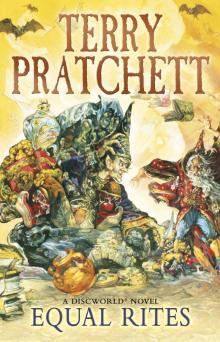 Equal Rites
Equal Rites A Hat Full of Sky
A Hat Full of Sky The Light Fantastic
The Light Fantastic Mrs Bradshaw's Handbook
Mrs Bradshaw's Handbook Wyrd Sisters
Wyrd Sisters Soul Music
Soul Music Small Gods
Small Gods Sourcery
Sourcery Reaper Man
Reaper Man Night Watch
Night Watch Lords and Ladies
Lords and Ladies The Fifth Elephant
The Fifth Elephant Monstrous Regiment
Monstrous Regiment The Truth
The Truth Witches Abroad
Witches Abroad Eric
Eric Going Postal
Going Postal Men at Arms
Men at Arms Jingo
Jingo The Amazing Maurice and His Educated Rodents
The Amazing Maurice and His Educated Rodents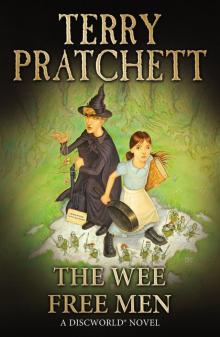 The Wee Free Men
The Wee Free Men Pyramids
Pyramids Wintersmith
Wintersmith Moving Pictures
Moving Pictures Carpe Jugulum
Carpe Jugulum Interesting Times
Interesting Times Maskerade
Maskerade Making Money
Making Money The Shepherd's Crown
The Shepherd's Crown Hogfather
Hogfather Troll Bridge
Troll Bridge The Last Continent
The Last Continent The Sea and Little Fishes
The Sea and Little Fishes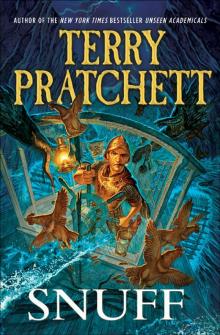 Snuff
Snuff Unseen Academicals
Unseen Academicals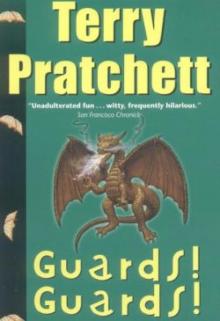 Guards! Guards! tds-8
Guards! Guards! tds-8 Jingo d-21
Jingo d-21 Turtle Recall: The Discworld Companion ... So Far
Turtle Recall: The Discworld Companion ... So Far The Fifth Elephant d-24
The Fifth Elephant d-24 Discworld 39 - Snuff
Discworld 39 - Snuff The Long War
The Long War Only You Can Save Mankind
Only You Can Save Mankind The Science of Discworld III - Darwin's Watch tsod-3
The Science of Discworld III - Darwin's Watch tsod-3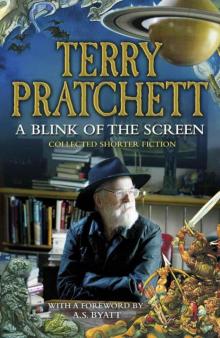 A Blink of the Screen: Collected Short Fiction
A Blink of the Screen: Collected Short Fiction Unseen Academicals d-37
Unseen Academicals d-37 Wings
Wings Making Money d-36
Making Money d-36 A Blink of the Screen
A Blink of the Screen Johnny and the Bomb
Johnny and the Bomb Dodger
Dodger Strata
Strata Discworld 02 - The Light Fantastic
Discworld 02 - The Light Fantastic The Folklore of Discworld
The Folklore of Discworld The Science of Discworld
The Science of Discworld The Unadulterated Cat
The Unadulterated Cat Raising Steam: (Discworld novel 40) (Discworld Novels)
Raising Steam: (Discworld novel 40) (Discworld Novels) The World of Poo
The World of Poo Discworld 05 - Sourcery
Discworld 05 - Sourcery The Witch's Vacuum Cleaner: And Other Stories
The Witch's Vacuum Cleaner: And Other Stories The Science of Discworld II - The Globe tsod-2
The Science of Discworld II - The Globe tsod-2 Small Gods: Discworld Novel, A
Small Gods: Discworld Novel, A Men at Arms tds-15
Men at Arms tds-15 Tama Princes of Mercury
Tama Princes of Mercury The Last Hero (the discworld series)
The Last Hero (the discworld series) The Long Utopia
The Long Utopia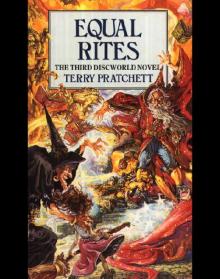 Discworld 03 - Equal Rites
Discworld 03 - Equal Rites Terry Pratchett - The Science of Discworld
Terry Pratchett - The Science of Discworld The Long Earth
The Long Earth The Carpet People
The Carpet People The Sea and Little Fishes (discworld)
The Sea and Little Fishes (discworld)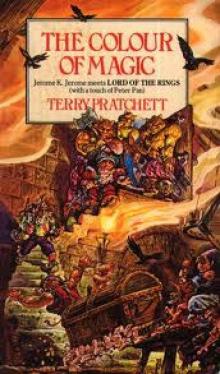 The Colour of Magic
The Colour of Magic Discworld 16 - Soul Music
Discworld 16 - Soul Music The Long Cosmos
The Long Cosmos The Dark Side of the Sun
The Dark Side of the Sun Monstrous Regiment tds-28
Monstrous Regiment tds-28 The Bromeliad 3 - Wings
The Bromeliad 3 - Wings Dragons at Crumbling Castle: And Other Stories
Dragons at Crumbling Castle: And Other Stories Night Watch tds-27
Night Watch tds-27 The Science of Discworld I tsod-1
The Science of Discworld I tsod-1 The Bromeliad 1 - Truckers
The Bromeliad 1 - Truckers The Science of Discworld Revised Edition
The Science of Discworld Revised Edition The Abominable Snowman
The Abominable Snowman Father Christmas’s Fake Beard
Father Christmas’s Fake Beard The Bromeliad Trilogy
The Bromeliad Trilogy A Slip of the Keyboard
A Slip of the Keyboard The Wee Free Men d(-2
The Wee Free Men d(-2 Johnny and the Dead
Johnny and the Dead Mrs Bradshaw's Handbook (Discworld Novels)
Mrs Bradshaw's Handbook (Discworld Novels) Truckers
Truckers The Amazing Maurice and His Educated Rodents d(-1
The Amazing Maurice and His Educated Rodents d(-1 Diggers
Diggers Thief of Time tds-26
Thief of Time tds-26 Science of Discworld III
Science of Discworld III Dragons at Crumbling Castle
Dragons at Crumbling Castle Nation
Nation Darwin's Watch
Darwin's Watch Interesting Times d-17
Interesting Times d-17 The Bromeliad 2 - Diggers
The Bromeliad 2 - Diggers The Science of Discworld II
The Science of Discworld II